Popular colors of cats

Cats are one of the most popular types of pets. You can pick up a pet today, as they say, for every taste and color. By the way, despite the seeming variety of shades of feline fur coats, there are only a few groups of their colors and patterns.
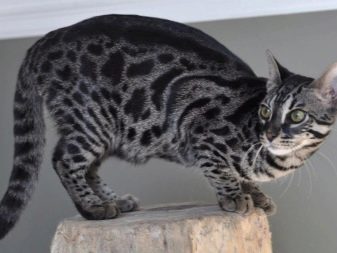

However, thanks to the miracles of genetics, each individual still gets its own unique color.
Features of pigments
Despite the variety of colors of cat hair, they all lend themselves to typing and can be attributed to one or another group of colors. It is genetically determined, which is why breeders of purebred cats are so strict about the pedigree. For in order for a kitten of a certain shade to be born that meets the breed standards, it is important to choose purebred parents.

A special pigment is responsible for the manifestation of a certain shade of a fur coat. It is called melanin and is classified into 2 types:
- eumelanin (absorbs sunlight and produces black pigment);
- pheomelanin (on the contrary, absorbs the rays of the sun and gives a red-yellow or orange pigmentation).


Melanin is present in the hair and looks like microscopic granules. Those, in turn, can have a different order of arrangement and concentration, this determines the peculiarities of the color of the animal.
Initially, the color of the cat's hair was due to the peculiarities of the life of a predator and served as a camouflage. Cats, unlike cats, have more color options. This is also due to genetics - the X chromosome is responsible for the presence of the pigment. In cats, there are 2 such chromosomes, in cats - one, and therefore females can have one of three basic pigments:
- red (OO);
- black (oo);
- tortoiseshell (Oo).
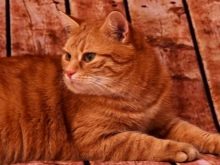


By the way, the last color option from the point of view of genetics is a chromosomal malfunction, a mutation. Such changes occur only in cats (only females are four-colored) and, like any mutation, this color does not continue, that is, the cat does not bring four-colored offspring.

Several genetic characteristics of color affect the character and appearance of the animal. So, snow-white cats, whose fur does not have pigment, often turn out to be deaf. The genome responsible for coat color often determines eye color. That is why the standards for a particular breed prescribe the permissible shade of the eyes.

Many myths have given rise to the peculiarity of the color of Siamese cats and their character. It is believed that he is nasty and vindictive. Although in this case it is fair to talk about the violation of breeding methods in the 80s, when the fashion for Siamese cats suddenly appeared.

In pursuit of profit, breeders without the necessary experience did not carefully check the pedigree and received, in fact, defective offspring. One of the options for marriage was just the same unfriendly character. Although it is worth noting that Siamese cats are one of the oldest breeds with a stable psyche, a breed focused on people.
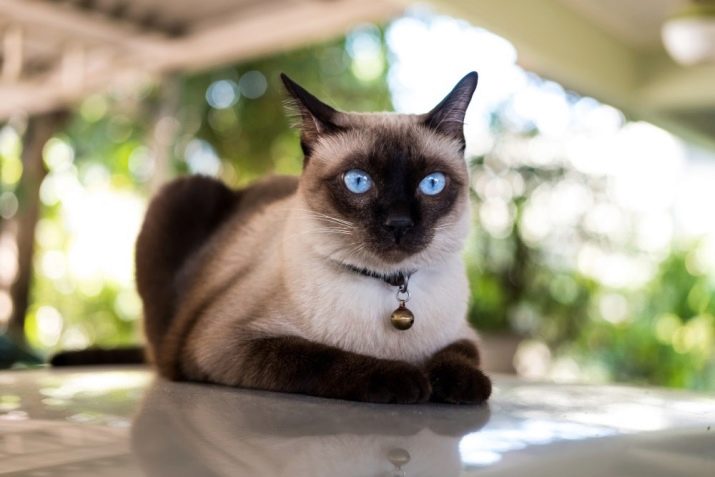
In addition to the main genes, there are others responsible for the brightness and saturation of the color, the presence of contrasts. As a result, subgroups of colors and rare breeds appear, we will consider them below. And for ease of navigation among the existing colors, use the table. It allows you to understand the groups and subgroups of colors. For example, tortoiseshell is only a subgroup, while piebald ones form a larger group.
Group | Varieties within the group |
Solid | Black Blue Red Chocolate Cream Tortoiseshell Blue cream tortie |
Tabby (tabby) | Marble Tiger Varnished Spotted Blue point Cake point Chocolate point Lilac point |
White | Solid white spots |
Albino | |
Dominant white | |
Piebald | Wang Harlequin Bicolor, tricolor Smoky Reverse smoky Silver tabby |
Color point | Sip point Cream point Red point Tabby point |
Silvery | Chinchilla |
Shaded | |
Cameo |
Solid colors
Solid-colored seals have uniformly dyed fur all over the body, muzzle, tail and limbs. The shade of the nose and paw pads are also the same. The appearance of spots, glare, stripes is a sign of marriage.

Despite the seeming simplicity of this color, it is the result of the painstaking work of specialists. It is the uniform solid color that is the first and most important criterion for assessing whether an animal belongs to an elite breed. (Nibelungs, Chartreuse, Bombays).


The hardest thing to achieve a solid color is with red and cream pigments. Therefore, a solid red fur coat may still have some semblance of a pattern or stripes.

Due to the peculiarities of the distribution of chromosomes, males are most often born with redheads.
Solid black is quite common. Gone are the days when it was believed that a black cat would bring misfortune. Today, pets with a coat color like the darkest night are among the most popular. There is even a breed (Bombay cats), the coat of which is exclusively black.
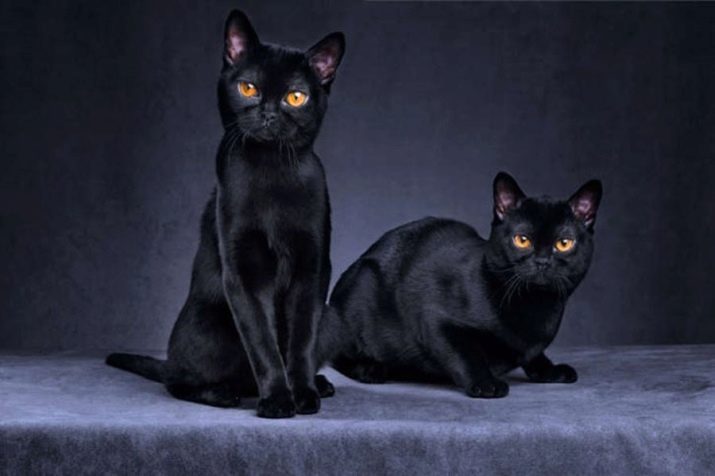
Despite the simplicity of color, cats in black coats require special care. Burning out in the sun, improper diet or grooming may cause your pet's coat to take on a dirty brownish tint.
Creamy shades are also difficult to dilute. The color of the coat should not be faded, moderately saturated, and the shade of the nose and paw pads should match the tone of the fur coat as much as possible. The presence of a lighter or white undercoat is unacceptable. The eyes of the solid color cats are copper or orange, the paw pads and nose are pink.Among the most valuable breeds with a complex solid shade are cinnamon and fawn Briton, lilac Briton.


Turtle color is considered quite valuable and complex. It can include a variety of shades of red and black palette. At the same time, black is always clearly visible and clearly expressed, and red color implies a slight blurring, tabby. For tortoiseshell color, the presence of stripes, white spots is also permissible.

Blue is called a solid light gray color. It is interesting that genetically he did not appear from white (this does not exist, if we are not talking about mutations), but from black. It must be uniform, without impurities. Typically, these animals have expressive green or orange eyes. You can also recognize them by their bluish-gray nose and paw pads.
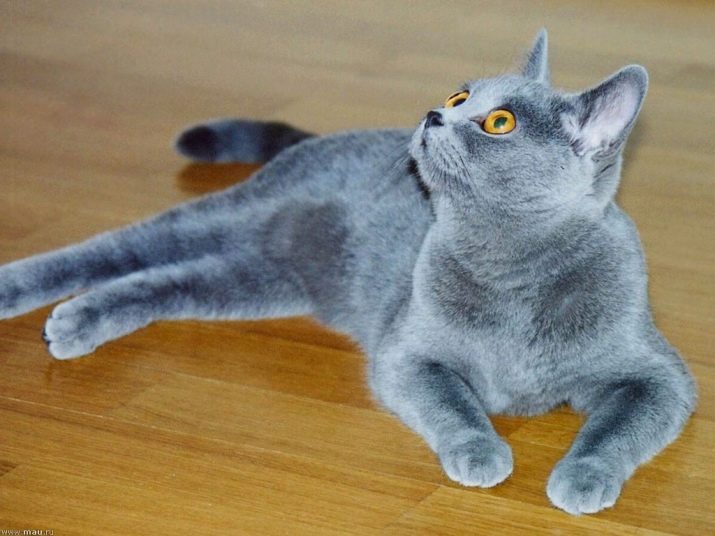
There is also a creamy blue tortoiseshell color, implying a chaotic arrangement of cream and blue spots on the body of the animal.
Cats with a solid color are sometimes referred to as whites, but only non-professionals make such a mistake. The fact is that white does not exist in nature.
Agouti colors
The concept of agouti color means the presence of zoning on the hairs of an animal. In other words, it resembles a striped police baton. In this case, the hair of a cat with an agouti color can have several shades. For example, one zone - have black pigment, the other - red or have no pigment at all... This group includes 3 subgroups that are large enough for consideration: tabby, shaded and "chinchillas".

Agouti is the name of a gene that is still not well understood. At the same time, the possibilities that the manifestation of this gene gives are truly extensive. It can be combined with most shades, which leads to the birth of both the usual "sailor" - yard tabby cats, and elite show individuals.
It is important to understand that not all cats with the appearance of stripes are agouti. For example, solid ginger cats can also appear striped just because of the difficulty of breeding the red gene.
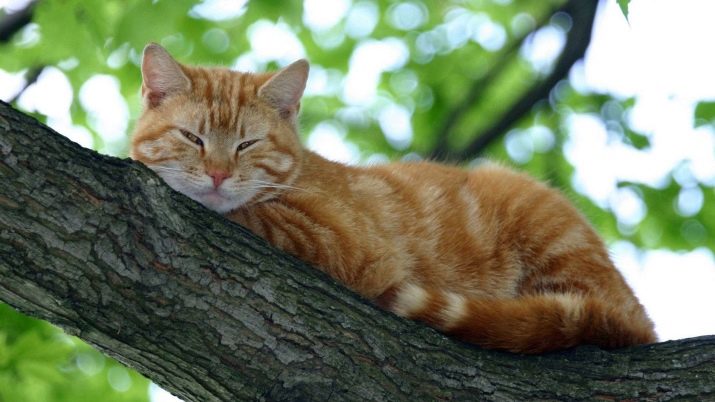
However, there is no agouti genome in the body of such individuals, which means that it is inadmissible to speak of their "stripes" as an agouti pattern.
Tabby
Such cats are often called striped by the people, but this is not true. The animal has no stripes. It's just that each hair of his fur is colored only for some of its part (for example, only the tip or 1/4, 1/8 of a hair). The result is an interesting pattern, originally intended to help cats camouflage in the wild, which was the color of the first non-domesticated cats.

An unusual pattern is always unique and, despite the similarities and a large number of animals with this color, each of them has its own unique pattern.
Sometimes it is not easy to determine the presence of a pattern on an animal's coat. In this case, the letter "M" (like the picture) on the forehead and the dark outline of the eyes will become a bright sign of tabby individuals. The hair on the tummy and the inner part of the tail is noticeably lighter in these cats.

The features of the pattern depend on genetic predispositions. Depending on how the stripes are located and their varieties, one or another pattern is formed. In this regard, tabbies are of several types.
- Marble. The pattern is formed by wide stripes on the sides, “rings” on the tail, stripes on the shoulder blades, reminiscent of the open wings of a butterfly.
- Tiger. Dark stripes stretch along the spine, thin stripes are found throughout the body, the tail and legs of the animal are decorated with “rings” that form stripes.
- Spotted. There are specks all over the body in a chaotic manner. An important point - they have approximately the same shape (oval) and sizes. On the legs and tail, the patterns are more elongated, so they can visually resemble stripes.



The Abyssinian or ticked color is distinguished separately. There is no clear pattern on the fur coat, it seems to be blurry, covered with a light veil.However, such an animal can never be confused with a cat with a solid color. Ticking provides a special shimmer in the coat.

It is worth noting another type of pattern - a combination of marble and spotted patterns. The fur coat of the animal is decorated with elongated spots, the edging of each spot is darker, and the middle is light, but still darker than the bulk of the hairs of the coat. Such a pattern can be seen on a marbled brown or rosette spotted Bengal.

Shaded animals
This group of colors refers to such varieties that are bred due to the partial suppression of melanin. As a result, silvery or smoky individuals appear, having a poorly visible, barely noticeable pattern. Among them, several are the most popular.
- Haze - have a small part of white pigment at the base of the hairs. Sometimes an animal is confused with an individual with a solid color, but only until the moment when it starts to move. Then the hairs open, a smoky color appears.
- Reverse haze - similar to the previous color, but the tip of the hair turns out to be white. This creates the feeling that the animal's fur coat is covered with frost (a typical representative is a Russian blue cat).
- Silver tabby - the hair of the animal has darkened tips, which, when viewed in bulk, form a pattern characteristic of a tabby.



Let's add a few words about the shaded smoke color (a bright representative is the Australian smoky cat). If the animal has a black tip of hair and a white base, it is black smoke. If, instead of black, there is a blue tint, we have a blue smoke color. White hair with purple hair is purple smoke, white with red hair is red smoke, with chocolate - chocolate smoke, respectively.

"Chinchillas"
Chinchilla cats are a variety of individuals with an agouti color. Chinchillas also have zone-colored hairs. In this case, it is the white base of the hair and the color is 1/3 or 1/8 of the hair. In other words, only the tip of a hair is colored.
That is why they have a more pronounced color and may even have a pattern.
The coat of "chinchillas" looks more elegant, light, a bit like the color of foxes or chinchillas. In addition, the coat is soft and fluffy. The black rims of the eyes and nose and the black paw pads make them even more attractive. Chinchilla eyes are bright green.

There are 2 types of chinchillas:
- tipped (have light fur, 1/8 of which is dark at the very tip);
- shaded (have a similar color, but 1/3 of the fur remains dark, this is also the tip).
In these varieties, due to the white undercoat, the color of the fur coat is close to silver. It seems as if a light silvery haze has enveloped the animal's fur. There is also a golden variety of chinchillas. In such individuals, the undercoat has a soft apricot or reddish color. The tip of the hairs is dark.

Among the most famous representatives are Scottish, Persian, British chinchillas. Despite the fact that this breed is quite young, its representatives are distinguished by good health and stable psyche.

This is due to the fact that chinchilla cats are bred on the basis of 2 ancient breeds.
Colorpoint: a variety of beautiful flowers
Translated from English, the name of this group means "colored tip". Indeed, the animal has a light body, and the tips of its ears, paws and muzzle have a darker shade. Individuals of this group can be identified by the darkened areas on a lighter coat. Siamese and Himalayan cats are considered typical representatives of this group.

The color "on the tip" can be not only darker than the basic tone of the coat, but also tabby, tortoiseshell.
To understand the peculiarities of the color, it is useful to know the principle by which these very names are built: the main color + the pattern (if any) + the word "point". For example, seal point (brown on light), tabby point.

Some cat breeds have their own colorpoint names. So, Persians with a Siamese color are usually designated as Himalayan. The drill has its own line of names. Pros might just say purple, sable, chocolate. However, in relation to this breed, there will be not a solid color, but a color-point.

Pied color of wool
Piebald color also means a cat with a white color and spots on it. Depending on the type of spots, the following piebald varieties are distinguished:
- van - most of the body is white, only on the head and tail (less often on the back of the paws) there are colored spots;
- harlequin - colored spots are scattered over the white body, which are on the head, paws of the animal and on the sides, the tail usually has a solid color.
- bicolor (two-color) - the presence of white is minimal, usually the tips of the paws, ears, "medallion" on the neck;
- calico (or tricolor) - most of the animal's body is white, the rest has a tortoiseshell color.

It should be said that white itself does not exist in nature. This is either a genetic malfunction (albinos) or the result of melanin suppression. However, in the latter case, it is correct to say that a white animal has white spots on a snow-white coat. It is clear that they merge, and therefore for a layman such a cat is just white.

For popular colors of cats, see the next video.
































